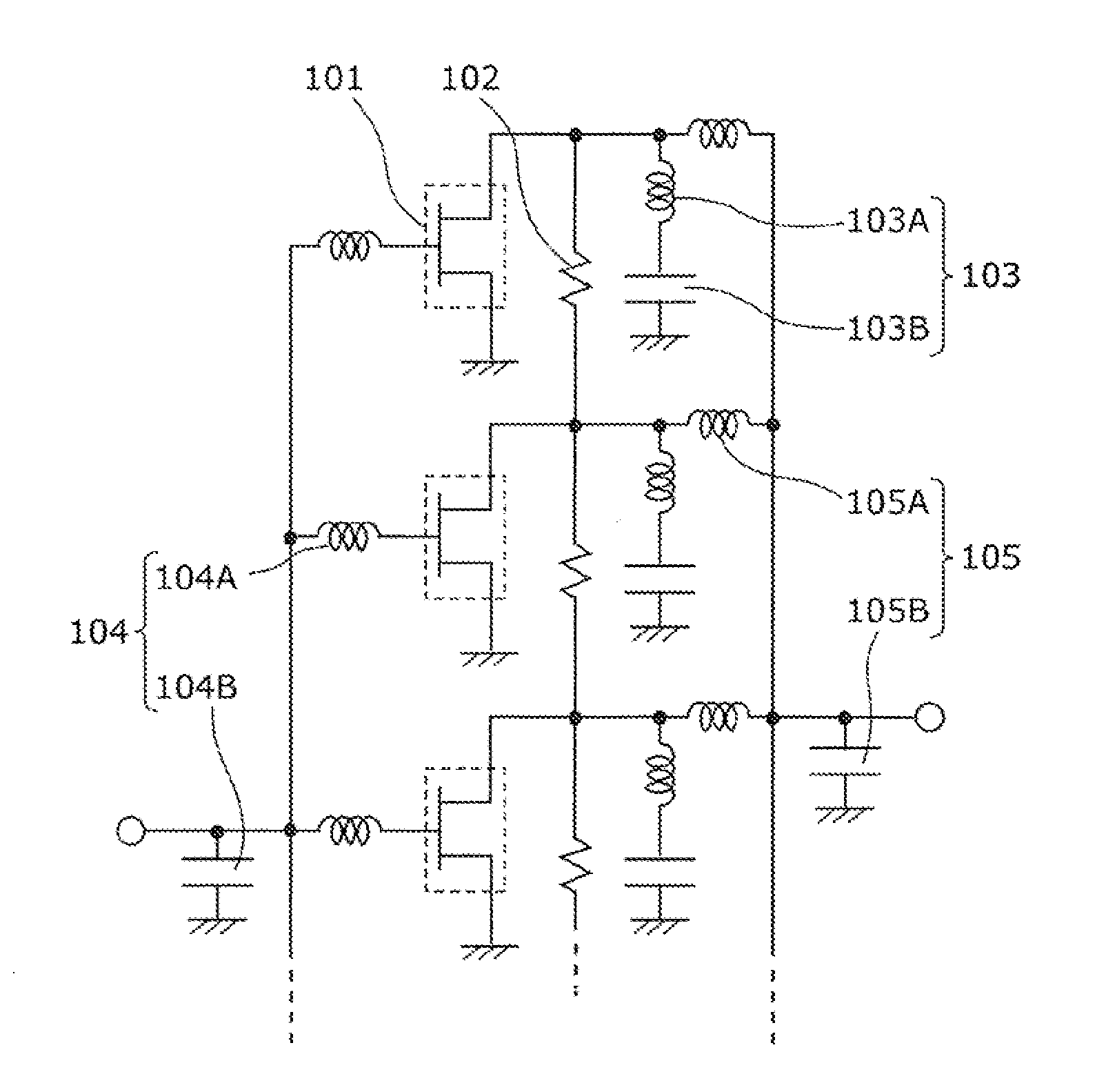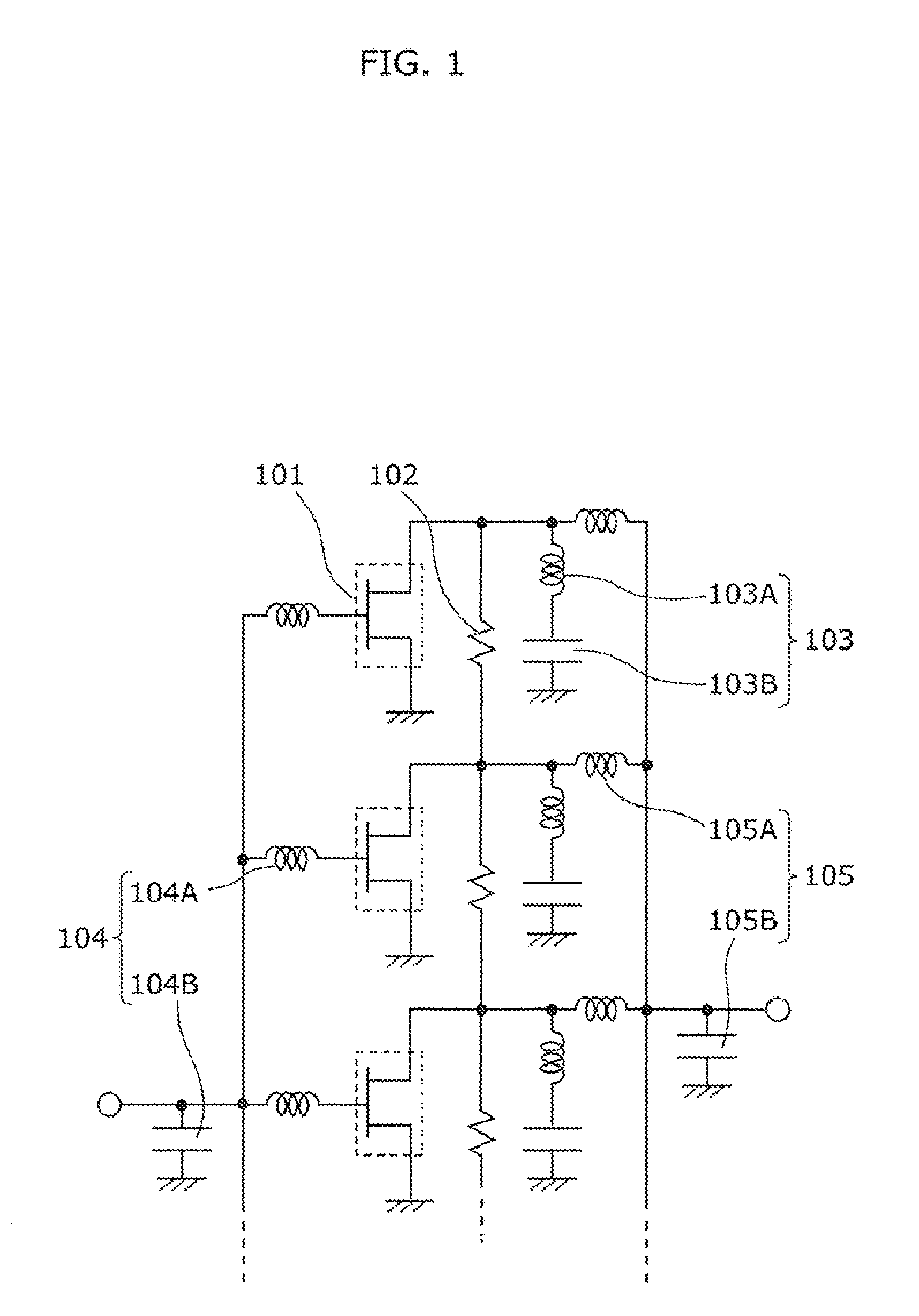Radio frequency amplifier circuit
a technology of amplifier circuit and frequency, applied in the direction of amplifiers with semiconductor devices only, semiconductor/solid-state device details, etc., can solve the problems of reducing the reliability of a device, difficult heat release design, and reducing efficiency, so as to achieve high efficiency and stability.
- Summary
- Abstract
- Description
- Claims
- Application Information
AI Technical Summary
Benefits of technology
Problems solved by technology
Method used
Image
Examples
embodiment 1
[0059]FIG. 1 is a circuit diagram which shows a radio frequency amplifier circuit according to Embodiment 1 of the present invention. The radio frequency amplifier circuit shown in FIG. 1 includes a plurality of low-output transistors 101 arranged in parallel, a resistor 102 disposed between drain output terminals of adjacent low-output transistors, a harmonic processing circuit 103 connected to each of the output terminals of the low-output transistors 101, an input-side fundamental matching circuit 104, and an output-side fundamental matching unit 105.
[0060]Each of the low-output transistors 101 is a first transistor which has a narrow gate width Wg, and outputs an amplified radio frequency signal. The amplified radio frequency signal passes through the output fundamental matching circuit 105, and is collected to be a high output. The high output is supplied from an output terminal of the radio frequency amplifier circuit.
[0061]The resistor 102 is an output-side resistor which con...
embodiment 2
[0093]FIG. 3 is a circuit diagram which shows a radio frequency amplifier circuit according to Embodiment 2 of the present invention. The radio frequency amplifier circuit shown in FIG. 3 includes a plurality of low-output transistors 301 connected in parallel, a resistor 302 arranged between drain output terminals of the adjacent low-output transistors 301, a harmonic processing circuit 303 connected to each of the drain output terminals of the low-output transistors 301, an input-side fundamental matching circuit 304, an output-side fundamental matching circuit 305, a resistor 311 arranged between gate input terminals of the adjacent low-output transistors 301, a harmonic processing circuit 312 connected to each of the gate input terminals of the low-output transistors 301.
[0094]The radio frequency amplifier circuit shown in FIG. 3 according to Embodiment 2 is different from the radio frequency amplifier circuit shown in FIG. 1 in a point that the resistor 311 and the harmonic pro...
embodiment 3
[0115]FIG. 5 is a circuit diagram which shows a radio frequency amplifier circuit according to Embodiment 3 of the present invention. The radio frequency amplifier circuit shown in FIG. 5 includes a plurality of low-output transistors 501A and a plurality of low-output transistors 501B both of which are connected in parallel, a resistor 502 arranged between drain output terminals of the low-output transistors 501A and 501B which are adjacent to each other, the harmonic processing circuit 503 connected to each of the drain output terminals of the low-output transistors 501B, the input-side fundamental matching circuit 504, and the output-side fundamental matching circuit 505.
[0116]The radio frequency amplifier circuit according to Embodiment 3, which is shown in FIG. 5, is different from the radio frequency amplifier circuit in FIG. 1 in a point that the resistor 502 and the harmonic processing circuit 503 that are arranged in the output side are not connected to each of the low-outp...
PUM
 Login to View More
Login to View More Abstract
Description
Claims
Application Information
 Login to View More
Login to View More - R&D
- Intellectual Property
- Life Sciences
- Materials
- Tech Scout
- Unparalleled Data Quality
- Higher Quality Content
- 60% Fewer Hallucinations
Browse by: Latest US Patents, China's latest patents, Technical Efficacy Thesaurus, Application Domain, Technology Topic, Popular Technical Reports.
© 2025 PatSnap. All rights reserved.Legal|Privacy policy|Modern Slavery Act Transparency Statement|Sitemap|About US| Contact US: help@patsnap.com



